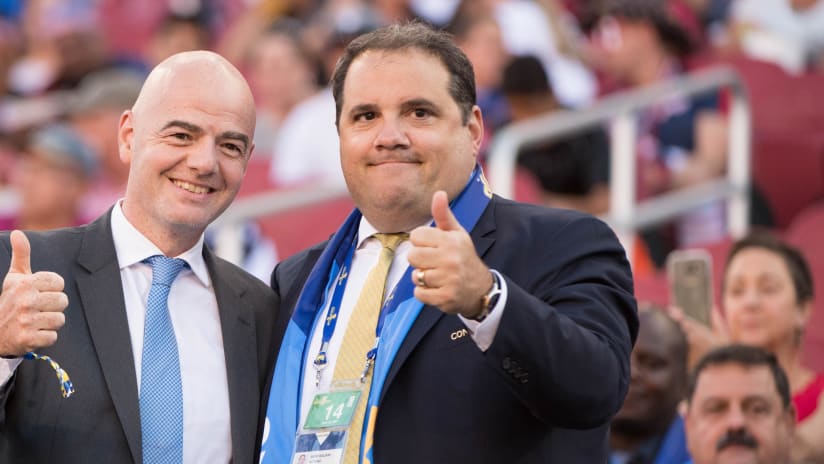MIAMI – Eight Concacaf teams in one World Cup. Can you imagine?
The 2026 FIFA World Cup in North America should be a transformative event not only for the three host nations, but the entire region, Concacaf president Victor Montagliani declared on Thursday, throwing down a challenge to his organization’s member nations to seize the tournament as their own.
“We have an opportunity to have eight teams in the World Cup 2026,” Montagliani said in a sitdown with Alexi Lalas at the 2018 Soccerex convention at Marlins Park. “And really with our Nations League, with our development programs, [that’s] our number-one goal at Concacaf, and our challenge to our federations.”
The 2026 event, to be hosted jointly by Canada, Mexico and the United States, will mark the probable debut of an expanded World Cup format, growing from 32 participants to 48, and the qualification process is still years away from being officially determined by Concacaf and other confederations.
But it’s clear to see that the days are numbered for the current local format, dominated by the iconic “Hexagonal” final round of World Cup qualifying. And Montagliani, who has overseen his organization’s rebirth after corruption scandals of the past, sounds bullish about driving a strong regional presence in eight years’ time.
“Obviously we’ve got a while to go in terms of the format,” the Canadian executive told MLSsoccer.com after his session. “How you would qualify for a World Cup, first within Concacaf, is up to us. So we haven’t determined that. Obviously a Hex won’t work, because we have more teams. We also will obviously be pushing for three automatic berths for the host nations, that is a decision that will be made ultimately by FIFA, but we’re confident in that.
“And then after that we’ve got to see what the format would be. From there we would have three other teams qualify and then hopefully two teams go to an intercontinental playoff and hopefully we would get eight. But we’re a few years away from determining what kind of format, and I don’t think we’d get there before 2020, at least.”
Automatic host bids might ease the nerves of United States and Mexico fans, but would it rob Concacaf’s qualifying process of its two marquee attractions?
“No – one of those nations didn’t get to Russia, so as you can see the quality of Concacaf has gone up,” said Montagliani. “And by that time we’re going to have six years of Nations League, another three Gold Cups, an improved Champions League. You’re going to see the quality increase. US and Mexico will always be US and Mexico, but I think what you’re going to see is rather than having a Hex where we have six teams that are competitive, we’re probably going to have 12 to 14 teams that are competitive. So I’m not concerned about that.”
Eight Concacaf participants at a World Cup would double the region’s current record of four, a milestone reached at the 2006 and 2014 World Cups (and three reached the knockout stages in Brazil four years ago). In the bigger picture, Montagliani envisions 2026 driving marked gains in quality and competition across a region currently known for a few giants surrounded by swarms of minnows and smaller fish.
“Yes, the hosts are the three countries, but really it’s a Concacaf World Cup in the sense that that’s where the opportunity lies,” he told Lalas. “It’s not just the 32 days in 2026, it’s this eight-year runway where every nation in Concacaf has the opportunity to use it as a north star. I know already, talking to some of the federations, they’re already tweaking their development programs and saying for example, ‘There’s no use us looking at our senior team right now, let’s look at our U-13s, U-15s, and let’s start building there.' So 2026 already changed the mentality of development within our region, because they’re using it as a north star. So I think the opportunities are immense.”
Montagliani also shared his thoughts on the first edition of the revamped Concacaf Champions League, which switched to a single-elimination knockout format for this year and featured several riveting occasions, from Toronto FC’s deep run to Chivas Guadalajara’s dramatic penalty-kick shootout triumph in the cup final.
“Big success, obviously. Great numbers, both TV-wise and even in the stands,” said Montagliani. “But we’re always looking – we had a meeting not too long ago to see how we can still improve it, because I don’t think you should rest on your laurels. And don’t forget it’s a two-phased approach, we have the Concacaf League and then we have the Champions League. So we’re looking at the Concacaf League as well, how can we improve that for teams that qualify from there into the Champions League. So there’s ways I think we can still improve it more, but we’re really happy with the change that we instituted last year.”













